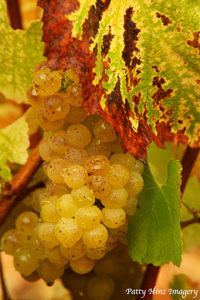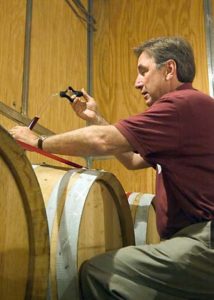The Windy Oaks Approach to Winemaking
 After harvest, the making of Windy Oaks Estate wine begins in earnest, using classic Burgundian techniques, with gravity feed and minimal handling. Both our estate grapes, here in Corralitos, and our managed grapes from Chalone and Santa Lucia Highlands, receive the same treatment in the winery. Throughout harvest and winemaking, the grapes are handled very gently. A wine-writer recently described our approach as ‘extreme minimal intervention’—we try not to manipulate the wine, and use no additives such as enzymes or acidulation.
After harvest, the making of Windy Oaks Estate wine begins in earnest, using classic Burgundian techniques, with gravity feed and minimal handling. Both our estate grapes, here in Corralitos, and our managed grapes from Chalone and Santa Lucia Highlands, receive the same treatment in the winery. Throughout harvest and winemaking, the grapes are handled very gently. A wine-writer recently described our approach as ‘extreme minimal intervention’—we try not to manipulate the wine, and use no additives such as enzymes or acidulation.
Our winemaking approach for our red grapes is exemplified by our approach to pinot noir (which is over half the grapes we process). There are a variety of styles of pinot noir, in part influenced by the quality of the grapes themselves and in part based upon the winemaking techniques. Our unique sites combined with our winemaking approach result in a wine which is complex and layered, and ages well. We complement our grape quality by using top-quality French oak barrels with very exacting specifications. Because pinot noir grapes are among the most sensitive to the way they are handled, we make wine in a way that minimizes the amount of handling, and, as mentioned, relies on gravity throughout the winemaking process, including bottling.

Prior to the start of fermentation, we cold soak the grapes for three to five days, to gain maximum non-alcoholic extraction. We use a naturally occurring yeast to forego the use of SO2 at the crusher. Following traditional Burgundian techniques, we ferment in small open-top fermenters, leaving up to 30% whole clusters in the must in years when the stems achieve a high degree of ripeness and extending maceration to ensure maximum extraction from the skins and seeds, and maximum phenolic integration. We also do some 100% whole cluster fermentations.
Most of our fermentations start with wild yeast which occurs naturally on the grape skins in the vineyard. In about half of the fermentations, we let the wild yeast take the fermentation to dryness; in the others, we inoculate partway through fermentation with one of several Burgundian yeasts that we think complement our terroir. We run off the free-run juice by gravity and then press the remaining must using a small, very gentle, computer-controlled basket press. Malolactic or secondary fermentation is left to occur naturally in the barrel and usually completes the following spring.

After press, the wine is aged in special French oak barrels, using approximately 35% new wood. We visit our barrel makers in Burgundy each year and work with them to get very tight-grain oak, which has been aged by the barrel maker for three to five years prior to making the barrels. We also want a light but long toast. These factors allow the barrels to give structure to the wine without overpowering the more subtle nuances in the wine. Aging time depends on the characteristics of the particular vintage, but is typically in the range of 17-27 months. The wine is bottled unfiltered and unfined, and aged in the bottle as necessary before release.
We utilize a similar process for our Chardonnay and other white wines, except that we press the whole cluster after harvest or following an overnight soak on the skins (depending on phenolic ripeness), barrel ferment the juice, and age in French oak on the lees for about 15+ months. We believe that the Chardonnay and other white wines benefit substantially from the very gentle handling they receive during the winemaking process. Contrary to typical industry practice, we bottle by gravity without filtering or fining to ensure retention of complexity and subtle flavor nuances.
We strive to make our wines, whether red or white, nuanced and complex and to faithfully reflect their unique terroirs. We have found that our approach, combined with the unique terroirs we farm, produces wines that age well and complement a wide variety of foods.